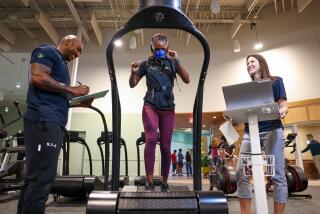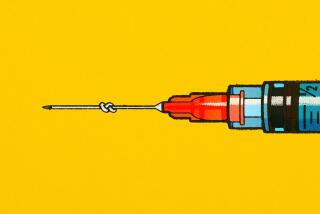A Lighter Touch : âNetworkâ Chiropractors Tap Gently to Release Pain in the Body and the Mind
It looks like a scene straight from âOne Flew Over the Cuckooâs Nest.â
Ten patients lie on massage tables. On one, a woman sobs; the guy next to her laughs uncontrollably. The other folks are silent, but two breathe so deeply that their spines undulate as gracefully as waves.
Welcome to Network, an approach to chiropractic in which gentle spinal adjustments can produce dramatic, cathartic releases--physical and emotional.
The method is attracting a small but growing number of celebrity patients and a general audience too. Itâs gaining fans among those plagued with chronic pain and among human-potential junkies who say it loosens up their minds as well as their bodies.
Network uses light touches and taps rather than jarring, aggressive manipulations--the back-cracking standard in many chiropractorsâ offices. The taps often leave patients crying, laughing, yelping or shaking as they re-experience traumatic events.
âIâve cried my guts out on the table,â says singer-songwriter Rosanne Cash. âItâs incredibly powerful. Itâs been life-changing for me. My body definitely feels better. I definitely have more energy.â
Cash has been receiving Network adjustments for nine classically stressful months: âIn that time, I was separated from and subsequently divorced my husband. I moved twice. Network kept me from going out of my mind. Last summer when I was on the road, I sought out Network chiropractors around the country, digging them out like Easter eggs. Iâve been to about 20.â
Network is practiced by about 300 chiropractors in the United States, says its creator, Dr. Donald Epstein, a chiropractor based in Yonkers, N.Y. He estimates that 1,000 other chiropractors (among the estimated 39,000 nationwide) use Network applications along with more conventional methods.
Critics contend that there has been no scientific testing of Networkâs effectiveness, and they caution that it might not be for everyone. They say people who are not ready to re-experience traumatic events are unsuited for Network and might be better off in psychotherapy.
Epstein counters that Network is safe because âthe bodyâs innate intelligence will never do anything to harm the body.â
Only two years out of chiropractic school, he began developing the method in 1979 at age 25. He chose the name because the body is essentially a network in which everything is linked.
Much of Network is based on about a dozen now-traditional chiropractic techniques, but Epstein expanded them and designed a new system for how and when they might be used.
âMost chiropractors go for bone crunching. We only do those type of adjustments after weâve released all the tension from the spine and there is still a lack of recovery from a structural or physical trauma,â says Epstein, who trains chiropractors worldwide. (There are about 20 Network chiropractors outside the United States.)
âI donât claim Network is superior to other methods of chiropractic,â says Epstein. âIt honors all the major methods. A major difference is the sequence or timing with which we introduce the adjustments.â
Those adjustments are usually light touches to the body where the vertebrae attach to the meningeal system, the thin sheath covering the spinal cord. This tissue, he says, holds imprints caused by physical, emotional or chemical stress.
âAt first, when I was developing the work, I was quite shocked and frightened when someone would start yelling, âI was raped 15 years ago!â They were actually reliving the experience in the office, and all I was doing was holding a four-second contact of about four ounces (of pressure) or so on one particular vertebra,â Epstein recalls.
âPeople naturally started laughing and crying and telling me about events they were releasing. It could have been the loss of a loved one, anything.â
Not all patients consciously re-experience events. Some say their time on the massage table seems uneventful--except that they feel less pain and more vitality afterward.
Epstein isnât sure why people release old traumatic events, but he has a theory: âThe body works in dominant patterns. It gets stuck in habits of behavior. If you run across the street, your heart will accelerate and, hopefully, when you get to the other side, it will slow down again. If it doesnât, itâs stuck in an unwanted dominant pattern. The difficulty arises when the body gets stuck in a pattern and doesnât reset itself. This is known as an illness or disease.â
As for why people sometimes cry, laugh or express other emotions during their releases, Epstein explains that âthe release of tension usually equates to the release of emotion.â
But some Network patients, usually those in more advanced stages of care, simply feel more energy surging through their bodies during the sessions.
Dr. Richard Kaye, a San Diego chiropractor, has been practicing Network exclusively for about two years and uses it himself for back pain. He describes the Network process by likening the body to a river:
âIf you have a river thatâs full of life force, itâs flowing. If the river is blocked by boulders, the river comes down to a trickle. In Network, our goal is to remove the boulders and let that vitality come through with the full glory of life.â
Now, he says, 20 non-Network chiropractors in the San Diego area turn to him and his chiropractor wife, Dr. Phyllis Books, for adjustments.
Because Network has had little public exposure, patients have tended to find practitioners through word of mouth. Referrals also are offered through the Assn. for Network Chiropractic in Brooklyn, N.Y.
Kaye believes Network is âjust not right for some people--yet. Theyâre not ready for change. Natural health care is scary to a lot of people.â
Even some chiropractors trained in the method are reluctant to use it. Epstein acknowledges that only about a third of the estimated 3,000 chiropractors he has trained since 1984 practice Network.
âOne of the reasons some chiropractors are opposed to it is because people have these very loud releases and go through all these emotions,â says a Network chiropractor who asked not to be identified.
âTo the outside world that doesnât understand it, it looks like a crazy cult, some sort of holy-roller thing. And itâs especially frightening to people who think that chiropractors are quacks anyway.â
Dr. Hyla Cass, a psychiatrist who has worked with patients undergoing Network adjustments, finds merit in the method but cautions that itâs not for everyone.
âAll together, I think Network is good,â says Cass, an assistant clinical professor of psychiatry at UCLA School of Medicine. âIt appears that the body can hold traumatic memories which can be accessed through a variety of body therapies, including Network. Network appears to be a powerful technique for releasing some of these memories and allowing the individual to become the full, natural, whole being that he or she was meant to be.
âBut Network may release emotional material that people arenât able to deal with. Or it may be released too rapidly for them to integrate it. In those cases, the work needs to be paced more slowly, and thatâs not always controllable. These people certainly need some psychological help in integrating the newly released emotional material.â
Epstein points out that many people receiving Network care also seek psychological counseling, and this is not discouraged. But he doesnât fear for patients who do not seek therapy: âThe body will choose when to release material it doesnât need, be it emotionally, physically or chemically. A person may cry, shake, sneeze or even vomit.â
To some chiropractors, claims made for Network appear âfar-fetchedâ because there have been no scientific studies of the method.
âIf (Network practitioners) wish to promote a particular approach to chiropractic, it should be subjected to the same kind of testing procedures that any form of chiropractic is,â insists Dr. James F. Winterstein, president of the National College of Chiropractic in Lombard, Ill.
But Dr. Jerome McAndrews, a vice president of the American Chiropractic Assn., suspects that the Network technique is âso psychologically based that it would be difficult to test scientifically.â
Epstein says there have been no scientific studies because he only recently found what he considers an appropriate research method for testing Network.
Meanwhile, many patients are not waiting for science to catch up with personal experience. Theyâre paying roughly $25 to $50 for each session. (Some Network chiropractors offer unlimited visits for $200 a month, and, as is the case with other chiropractic methods, many major medical insurance policies cover the adjustments.)
Consider Gail Elen, a former competitive downhill skier who has been treated by chiropractors throughout the world and has worked closely with sports medicine specialists.
âMy whole life Iâve had pain in my low back and neck, but I started to see results after four or five Network treatments,â says the Malibu resident and public relations executive.
Elen has received Network care for about a year from Dr. Michael Anderson at his Network Healing Arts Center in Santa Monica.
âI started to change as a person. Things from the past came up during the sessions--and then disappeared. Theyâre not issues for me anymore. Iâve also jumped to another income level. And for the first time in my life, Iâm really having fun.â
Or as actress and documentary filmmaker Margot (formerly Margaux) Hemingway says: âNetwork is one of the faster transformational tools around. Itâs a lot more fun than spending years with psychiatrists.â
More to Read
Sign up for Essential California
The most important California stories and recommendations in your inbox every morning.
You may occasionally receive promotional content from the Los Angeles Times.










